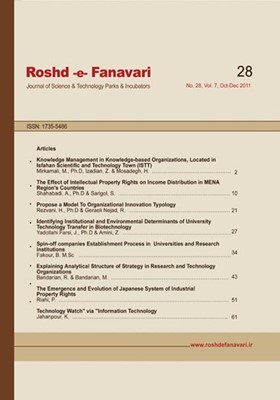-
-
List of Articles
-
Open Access Article
1 - Knowledge Management in Knowledge-based Organizations, located in Isfahan Scientific and Technology Town (ISTT)
Seyed mohammad Mirkamali Zeynab Eizadian Hadi Mosadegh -
Open Access Article
2 - The Effect of Intellectual Property Rights on Income Distribution in MENA Region Countries
Abolfazll Shahabadi Sara Sarygol -
Open Access Article
3 - A Model To Organizational Innovation Typology
Hamidreza Rezvani Roza Gerayeli nejad -
Open Access Article
4 - Identifying Institutional and Environmental Determinants of University Technology Transfer in Biotechnology
Jahangir Yadoollahi Farsi Zahra Amini -
Open Access Article
5 - Spin-off companies establishment process in Universities and Research institutions
Bahman Facoor -
Open Access Article
6 - Explaining Analytical Structure of Strategy in Research and Technology Organizations
Mahdi Bandariyan -
Open Access Article
7 - The Emergence and evolution of Japanese system of Industrial Property Rights
Parisa Riyahi -
Open Access Article
8 - Technology Watch” via “Information Technology
Kiyarash Jahanpour
-
The rights to this website are owned by the Raimag Press Management System.
Copyright © 2017-2025







